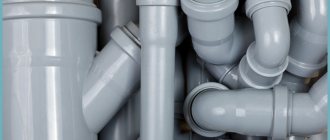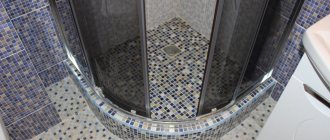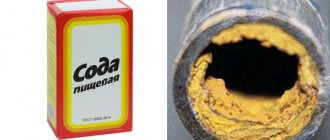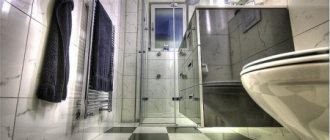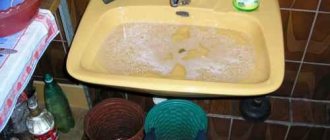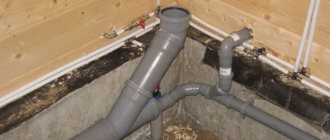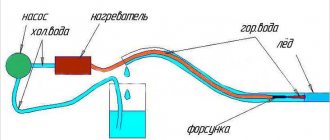Users of shower cabins often encounter this problem: after taking water procedures, the liquid leaves the tray very slowly.
The reasons for this can be completely different: a clogged siphon, a common sewer, or an incorrect installation of the cabin.
All these factors can lead not only to poor drainage, but also to the appearance of an unpleasant odor. In our article we will talk in detail about the reasons for slow drainage, as well as how to remove the blockage and clear the drain in the shower without consequences for the plumbing. After all, the use of aggressive chemicals can damage the siphon and pipes .
Why does water drain poorly?
To find the right method to solve the problem, you must first determine the main reason for the stagnation of water in the pan.
Long corrugation
When connecting a shower stall to a sewer, the siphon is often connected to the main riser using a corrugated pipe. In this case, it is very important to choose the length of the corrugation such that it does not sag .
But some inexperienced plumbers ignore this point and install a pipe that is too long.
Over time, it can further bend, thereby forming a second siphon. It will be very difficult for water to overcome it, so the drainage speed will decrease significantly.
To cope with this problem, you need to replace the corrugated pipe with a shorter one. You can also place bars or bricks under it so that it does not sag.
The most optimal solution to the problem of the second siphon is to replace the flexible corrugated pipe with a rigid, smooth one.
Incline
Often, liquid goes down the drain slowly due to the fact that the angle of the drain pipe is not maintained. As a rule, pipes with a diameter of 50 mm are used to lead shower cabins to the sewer.
For them, it is recommended to maintain a slope of 3 cm for each linear meter of pipe length . If your figure is lower, or the pipes are generally laid horizontally, you need to provide a steeper slope. But how to do that?
The problem is that it is not always possible to physically implement the slope. Very often, the shower siphon is located at the level of the socket of the general sewer system. That is, when they are connected, a horizontal section is obtained. In this case, there is only one way out - you need to raise the shower stall so that the siphon is higher and the drain gets the desired slope.
You can do this in two ways:
- lengthening the legs of the shower tray frame : can be done by replacing studs or lining bricks;
- erection of a podium and tiling it.
The first method is simple, but is not always able to provide the required lifting height. The second method will help raise the booth by 20 -30 cm, but will be very costly in terms of finances and time.
Blockage
The most common reason why water does not drain from the shower stall is a blockage. Inevitably, debris accumulates in the sewer system, which interferes with the normal operation of the plumbing. We will talk about this in detail below.
To avoid such blockages, you need to regularly flush the drain with hot water.
For meter owners, this method will cost a pretty penny. Therefore, it is better for them to use special means, which will be described in detail below. In addition, you need to clean the drain hole from hair and small debris at least once every three days.
Causes of smell in the bathroom
Depending on the nature of the problem, the bathroom may smell like rotten eggs (hydrogen sulfide), sewage, rot and mustiness.
The cause of sewer stench is a complex mixture of ammonia, methane, hydrogen sulfide, mercaptan and other substances. They are formed during the decay of organic waste - fat, hair, waste products, etc. Normally, this process takes place at the collector stage, but when wastewater is delayed, it can also occur in the sewage system of the house.
If the joints are poorly sealed, the toilet may smell not only of sewerage, but also of mustiness. This is due to the fact that with high humidity, mold actively develops in certain areas.
Poor ventilation
Ventilation is designed to exchange air, eliminate unpleasant odors and reduce air humidity.
The cause of stench due to clogged or improperly installed ventilation can be:
- lack of filtration of the bathroom space;
- penetration of smell from neighbors;
- maintaining high humidity after water procedures, the appearance of mold.
Clogged ventilation is a common problem in apartment buildings. Dead pigeons, rats and other large debris often get into the ventilation shafts of high-rise buildings.
If your apartment smells like sewage or mustiness, you should do a small draft test. To do this, you need to take an A4 sheet and bring it to the ventilation opening in the bathroom or toilet. If the sheet sticks to the hole, then there are no obstacles to air exchange. The free fall of the sheet indicates a blockage in the shaft.
One of the reasons for sewer smell is poor ventilation.
Blockage in the pipes and malfunction of the siphon
Malfunctions of the sewer pipeline can also lead to the appearance of a persistent pungent odor.
The problem may appear in the following cases:
- The layer of water in the water seal has dried out due to lack of water or prolonged non-use of the drain.
- A thick layer of waste has formed on the walls of the outlet, spreading an odor as it rots.
- The lower part of the siphon (glass) is filled with waste and sewage, the smell of which penetrates into the bathroom through the drain hole.
- When installing the flexible elements of the siphon, technical errors were made: strong stretching, excessive bending and deep immersion of the toilet corrugation into the general sewer outlet.
- There is a blockage in the pipes leading from the sink, toilet or bathtub that is preventing waste water from draining.
- Due to seepage of wastewater when the drainage drain was clogged, the water level in the hydraulic seal dropped critically.
A water seal is a water plug that prevents air from entering from the sewer. To create a seal, the siphon is curved. The bending point must be below the water level: the distance between them should be at least 2-3 cm.
Regular drainage of water renews the water in the hydraulic seal, so the plug itself does not emit unpleasant odors. If the siphon is installed incorrectly or the water does not drain for a long time, the liquid level decreases. This creates a corridor for the penetration of air from the general building sewer system.
Incorrect slope of sewer pipes
To ensure spontaneous drainage of wastewater, it is necessary to install a horizontal pipeline with a slight slope towards the sewer riser.
The degree of slope depends on the diameter (d):
- with d 50 cm (from the sink and bathtub), the slope should be 3 cm per meter of channel;
- with d 40 cm (from the sink, sink, bidet) - 3-3.5 cm per meter;
- with a diameter of 110 cm (from the toilet) - 1.5-2 cm per meter.
The second reason is improper bending of the pipe.
At lower slopes, the gravity system cannot move wastewater. If the level of the pipe decreases more sharply, then the rate of sewage flow increases. This leads to the fact that mostly liquid goes into the sewer, and large and dense waste is retained on the walls.
Deviation from the norms of the sewer slope in any direction provokes the occurrence of blockages. If the areas connecting the plumbing fixtures and the riser are crossed by a wall, the risk of blockage also increases.
Leaks and condensation
If the bathroom area is small and there are problems with ventilation, condensation settles on the walls and ceilings. In places where moisture accumulates, fungal colonies develop. Moldy finishes give off a damp and musty smell.
Condensation can form from both clean and waste water.
The reasons for the accumulation of moisture in areas of walls and ceilings are:
- leaks, pipe damage;
- depressurization of connections;
- rupture, cracking of corrugation.
If there are cracks, ruptures or other damage to sewer outlets, waste seeps out and collects at the lowest point of the site. If it is located outside the wall, then the sewage gets on the walls or floor, and its smell is detected quite quickly.
If the pipe inside the ceiling is damaged, the stench gradually permeates the concrete or wooden structure.
Incorrect installation
In addition to the incorrect slope of the sewer, the following installation errors can lead to the appearance of an unpleasant odor:
Incorrect installation may also be the cause.
Multiple bends and 90° turns. Installing sewer outlets at right angles increases the risk of blockage. If the pipeline needs to be rotated 90°, it is recommended to use 2 corner pieces with a 45° bend. This will avoid the effect of braking the drains and trapping large debris at the bend point.- No sealing gaskets. Rubber and silicone rings complicate installation, so unscrupulous workers may refuse additional sealing. Joints without gaskets begin to leak immediately after installation, so during installation you should pay attention to their presence and additional sealing. O-rings can come complete with a siphon (for a sink, bathtub) or be sold separately (for the junction of a toilet corrugation and a sewer).
- Direct connection of sewerage to plumbing fixtures. If there is no bend in the siphon, the pipeline is not blocked by a water plug (hydraulic seal), so odors from the sewer freely penetrate into the room. To block the flow of air from the drain, you should connect the plumbing to the outlet through a curved siphon, taking into account the law of communicating vessels.
- Absence or thinning of the drain pipe. This element of the sewer system is responsible for communicating the riser with the atmosphere. If there is no drainage outlet, then when the wastewater moves downward, a vacuum effect occurs in the system. Rarefaction leads to drying out of the water seal.
- Some apartment owners on the upper floors dismantle the outlet to seal the hole in the ceiling. Owners of rooms located below can choose an element of a smaller diameter to free up space in the bathroom. To ensure the drainage function, the diameters of the fan channel and the riser must match.
During the initial installation of the sewer system, it is recommended to test its tightness and flow rate of wastewater. To do this, put a plug on the pipeline, fill it with water and monitor for leaks.
Poor quality sealing of joints
When assembling a sewer system, all joints must be treated with sealants. To prevent wastewater leaks, sealing cuffs, silicone tapes, polyurethane, silicone and bitumen pastes are used.
The sockets of cast iron pipes are caulked, i.e. clogged with fibers treated with epoxy resin, bitumen or other sealant.
Refusal of additional sealing or poor-quality processing of joints leads to the appearance of an unpleasant odor. If sealants and sealants were not used when installing sewerage inside the ceilings, the smell may spread into several adjacent rooms.
The most typical leak locations are:
- connecting the corrugation to the toilet;
- joint of a flexible toilet pipe with a common outlet;
- connection of the sink and bathtub drain hole with a siphon.
There may be poor-quality sealing of the joints.
Causes
There are 3 main causes of blockage.
1. Debris and hair. After each shower, your hair, threads from clothes, and pet hair get into the drain, and it gradually becomes clogged.
Even if you carefully monitor the cleanliness of the bathroom, this is inevitable. After some time, the debris clumps together and forms a blockage, which complicates the drainage of water from the pan.
2. Small items. Sometimes it happens that small objects fall into the drain hole: stones from jewelry, pieces of gel polish, or something from the floor. Such things do not pass down the siphon and interfere with the outflow of water.
3. Grease and soap residue. Deposits of grease and soap accumulate on the walls of the sewer. Over time, the layer of dirt grows, debris sticks to it, and water begins to flow worse.
Classification and types of equipment
The siphon ensures the unhindered flow of dirty water and blocks unpleasant odors. The installation consists of a curved pipe.
It is the bending of the pipeline that helps retain some of the water that comes from the pan. Water accumulated in the curved segment prevents unpleasant odors from entering the room.
There are different types of siphons. But, taking into account the differences in design, they can be divided into 3 main types:
- bottle;
- tubal-knee;
- drain drain
How to fix it at home?
What to do if the shower drain is clogged? Below we present 4 of the most effective methods, which very often help with the formation of a blockage:
plunger
A plunger is one of the simplest devices for cleaning plumbing drains. It is found in almost every home.
To remove a blockage with a plunger, before using it,
you need to lubricate its edges with Vaseline - this will help the suction cup better adhere to the plumbing fixtures.
How to use it correctly?
If the shower stall is dry, fill it with a little water so that it covers the head of the plunger. Its valve must be positioned so that the edges are completely adjacent to the surface and the drain is closed. Place the plunger at a slight angle to allow air to escape from the siphon. After all the preparatory stages, you need to make about 20 back-and-forth movements up and down. When you have removed the fixture, run hot water and flush the drain hole - this will help remove any remaining debris.
Disassembling the siphon
If the previous option did not help, you can disassemble the shower siphon. In general, it is recommended to clean it not only when you have a problem with draining water, but also for prevention 4-6 times a year.
Cleaning and disassembly instructions:
- place a container under the drain to collect all the dirt and remaining liquid;
- remove the shutter nut, and then the flask itself;
- wait until all the water has flowed out of the water seal, then remove dirt from the pipe and remove plaque from the walls of the plumbing;
- rinse the elements under running water;
- put the siphon in place and make sure that the water drains normally.
Plumbing cable
If the water drainage is still poor, then the blockage has formed deeper and you need to use a plumbing cable. Cleaning the drain hole with its help is quite simple. The cable can be made from improvised materials, but it is better to buy it in a specialized store.
It is advisable not to insert the cable directly into the drain hole. For convenience, it is better to remove the siphon and work with the sewer pipe outlet.
When the cable has gone deep enough, you need to turn it several times and carefully remove it.
Hair or debris may become caught on the end of the fixture, preventing water from flowing down the drain. In case of cleaning with a cable, the drain must be rinsed with hot water after completing the plumbing work.
Can it be cleaned with cleaning agents?
You can also clean the siphon using household chemicals.
You need to be careful in choosing funds.
Aggressive components can corrode not only grease, hair and other debris accumulated in the pipe, but also the material that makes up the sewer system. The well-known “Mole” cannot be used for plastic pipes.
First of all, you need to pay attention to the label; it indicates for which pipes the product can be used. Below we present 3 of the most popular compositions that will help remove blockages.
Tire Turbo. As the advertisement says, it removes all known blockages in 5 minutes. In principle, it copes with blockages quite well, but not in 5 minutes. This usually takes at least 1.5 - 2 hours.
When used, chlorine is released in the form of gas, so good ventilation of the room is a prerequisite.
Sanox is a pure waste. Ideal for preventing and removing light blockages. Unfortunately, the composition cannot cope with heavy ones, but it guarantees complete safety for plastic pipes.
Bagi - pothan . The real heavy artillery among anti-clog products. It contains caustic soda, which reacts violently when in contact with water. The product is intended specifically for removing heavy blockages. For prevention and weekly cleaning, it is better to use softer compounds.
Wear gloves and a medical mask to protect yourself from chemicals.
As for the instructions for use, the label of each composition contains its own special algorithm for removing blockages, which you should definitely follow. This will protect your pipes from unwanted damage.
Traditional methods
But what to do if there are no suitable household chemicals at home, and the clog just won’t go away? Not everyone knows that substances that almost every person has at home can cope with simple blockages.
Soda and vinegar . An excellent combination that will allow you to cope with light stains in the shower drain.
- pour about 200 grams of soda into the drain hole;
- then pour a glass of vinegar (200 ml) of high concentration there;
- after the reaction is complete, flush the pipes with plenty of hot water;
- repeat the algorithm 2-3 times if the blockage does not go away.
If the cause of the blockage is lime deposits, you can try using another method: citric acid .
- pour 100-150 grams of powder into the drain;
- pour boiling water over it for 10-15 minutes;
- repeat the second step 3 more times;
- Sprinkle with plenty of hot water.
It is important to ensure that boiling water does not get on the acrylic coating of the shower tray , otherwise it can damage it.
Why is the water seal broken?
There may be several reasons for this phenomenon, so it is important to consider each case separately:
- The most common reason is improper installation of the siphon. If an ordinary product is installed that looks like a flask, where the pipe is not provided for lowering into the water inside the siphon, then most likely there will still be an unpleasant odor. It easily passes between the water and the walls of the device, thus freely entering the room. To prevent such a situation and make the water retain unpleasant odors again, you just need to lower the pipe into the water a few centimeters lower. Only it should not fall so that it rests against the bottom of the siphon.
- The problem may arise due to sagging of the corrugated tube. If you bend the elbow correctly, the corrugated tube will retain a certain amount of water at the lower level. As a result, the required water seal will be created in the system. After some time, the corrugation loses its rigidity and begins to sag, as a result of which the water level decreases and the water seal disappears. To prevent this situation, you can use special clamps that hold the tube in the correct position for a long time. You can also use regular electrical tape, which can be used to tie the tube as it should be.
- Often an unpleasant odor occurs due to fumes emanating from the siphon. As a rule, this happens due to long downtime of sewerage devices. If the system is not used, the water from the siphon will simply evaporate, and the water seal will break. Many owners of houses and apartments are interested in how to remove this smell and what measures can be taken to prevent this situation? Everything is much simpler than it seems at first glance. Before a long trip, it is recommended to pour a little vegetable oil into the drain hole of the plumbing fixture. Thus, due to the formation of a special film, water will not evaporate from the siphon. If such an incident could not be avoided, then you just need to drain more water to flush the siphon that has accumulated sewer odor.
- Installation errors or savings can also cause unpleasant odors. Illiterate professionals can overstretch the corrugated pipe or secure it in the wrong condition, which will result in a broken or missing water seal. In such situations, a bad smell appears immediately after the installation of new plumbing fixtures.
What else could cause unpleasant odors from the shower?
In fact, not all of the reasons for this problem are listed above. It is also worth noting a small leak in the sewer system, which supplies the same place in the bathroom with moisture. This may cause a musty or rotten smell. There may be a crack in the pipe from which the stench will escape into the room, bypassing the water seal.
checking the drain in the shower stall
A simple reason is the usual clogging of the siphon, which causes stagnant dirt and grease to accumulate.
Often the cause of the problem can be the plumbing fixture itself, especially if it is new and inexpensive. It should be noted that acrylic products can resemble a sewer smell, so it is important not to confuse them. If a good repair has been made, new plumbing fixtures have been installed, then most likely this is the situation that needs to be considered. This feature is explained by the fact that unscrupulous manufacturers of plumbing products use low-quality materials in production.
If the problem arose in a private home, then you need to consider the option of improperly laying sewer pipes and directly installing the devices themselves.
Methods to combat unpleasant odors
Of course, all plumbers claim that eliminating sewer smell is possible only with their help, but in fact, you can try to correct the situation with your own hands. The first thing you need to do yourself is to disassemble the siphon, clean it and rinse it under high pressure water. During the washing process, it is recommended to use household chemicals that will not only clean the device well, but also eliminate the unpleasant odor. If the drain is clogged, for example, with hair or other debris, you can clear it using special chemicals.
If the reason is improper installation of the plumbing fixture, then it is more advisable to seek help from specialists.
What to do if there is a sewer smell coming from the drain?
It may be that you regularly clean the room, fill the plumbing with chemicals, but this does not help. And the unpleasant smell of sewage from the drain is still present, how can you remove it?
It is worth noting that sewerage is not always the source of an unpleasant odor. Shower trays are often made from acrylic. If the technology is violated, an unpleasant odor may come from the pallet. In some cases it can be eliminated.
We recommend that you read our special article on why an acrylic bathtub smells and what to do about it?
To fix the problem, you need to find out where it is coming from.
Why does the shower smell like sewer? The most common reason is improper plumbing design. If the siphon is installed according to the rules, then the water will go into the sewer, and a small part will remain in the pipe. This creates a water seal that prevents unpleasant odors from filling the apartment. When there is no water seal, the sewer smell goes directly into the bathroom.
Don't ignore the unpleasant smell of sewerage. Even if it does not affect your mood and general condition in any way, you need to remember that it is harmful to your health. Hydrogen sulfide and ammonia can have a detrimental effect on the respiratory tract.
If everything is in order with the siphon design, then the reason may be a damaged sewer pipe. If the tube has come loose and does not fit tightly to the riser, an unpleasant odor may appear.
In addition, the problem may lie in the fact that the remains of skin and debris that accumulate in the pipe begin to rot. If you are sure that everything is in order with the plumbing, then you need to clean the siphon using the methods that we wrote about above.
How to eliminate the smell in the sewer in a private house
The solution to the problem of how to get rid of sewerage smell in a private house is directly related to the type of reason that caused its appearance; often the owner manages to cope with the problem on his own; in case of failure, the help of employees of specialized companies will be required.
Elimination of leaks
Leaks can appear due to damage to the pipeline or a violation of the tightness of the joints; the problem can be solved in two ways - by sealing the leakage area or replacing the pipe.
It should be noted that in domestic sewerage there is practically no pressure and liquid waste is transported by gravity, therefore, no high demands are placed on any sealing materials on the surface of the pipes in terms of the strength of their structure and the connection itself.
Repairing the defective area
If a crack or fistula appears in a PVC pipe, the defective area is sealed using one of the following methods:
- For a small fistula, which often appears in pipes as a result of an accidental drilling of the pipeline during repair work, the hole can be sealed with cold welding or epoxy resin.
- If the hole is large, apply a patch of rubber or other sealed soft material, gluing it to the pipe.
Rice. 8 Sealing holes in the sewer pipeline with improvised means
- For reliability, the entire pipe is wrapped in material, for example, a bandage is used, which is then covered with epoxy resin. The pipe can also be wrapped with adhesive tape or electrical tape; the latter is best used on a black fabric base due to its higher stretch coefficient, which allows you to wrap the damaged area tightly and with good tension. If you don’t have fabric tape on hand, a medical adhesive plaster, which has excellent adhesiveness and high extensibility, is a good substitute.
- If a crack has formed in a PVC pipe, it is better to repair it with a patch made from a piece of rubber, attaching it to the surface of the pipe using electrical tape or tape.
- If there is a long crack, it can be closed with a piece of any porous sealed material (rubber, polyethylene foam) and pressed on top with a rigid segment of a cut sewer pipe - this will create uniform pressing force and, accordingly, a high degree of sealing of the defect along the entire length.
- It is a good idea to fix the overlay fragment of the PVC pipe with clamps - this will provide a much higher degree of pressure than electrical tape or tape.
- The most reliable, aesthetic and correct way to seal cracks in a pipe is to use factory-made overhead clamps with sealing gaskets. They are a single thin clamp or products made from two rigid fragments, which are fixed and pressed to the surface of the pipe with nuts and bolts.
Rice. 9 Options for eliminating leaks with overhead clamps
Pipe replacement
If a leak occurs at the junction of two pipes, one of the main reasons is damage to the rubber sealing ring or its loss of its plastic physical characteristics. In this case, the leak is quite difficult to eliminate using the above methods and the pipe may need to be replaced.
When it is possible to disassemble a sewer section with a damaged pipe without high labor costs, the problem of replacing the pipe does not pose any particular difficulties. Even if the pipe was purchased from another manufacturer, its outer diameter of 110 mm and a similar inner diameter of the connecting socket have an unchanged rating with slight deviations that do not affect the tightness of the joint.
The situation is different if it is impossible to dismantle the section with the damaged pipe. In this case, the way out is to use an additional repair coupling in addition to the pipe. The essence of this method of installing any pipe section into a line section is that the coupling has a long socket and can move along the pipe for some distance.
Before installation, the assembly is prepared for replacement: a new pipe is cut and inserted into the coupling until it stops, so that the length of the connected parts corresponds to the free opening. Next, the pipe of the assembled unit is inserted into the socket of the pipeline on one side, and the coupling is pushed onto the pipeline from the other end, thus obtaining a sealed connection.
Rice. 10 Technology for inserting a tee into a pipeline section using a repair coupling with an extended socket
Correcting installation errors
Some of the main mistakes when installing sewer pipelines are failure to comply with the required slopes, incorrectly installed water seals, lack of cuffs at the points where drain hoses from household appliances enter the pipeline, lack of inspection in the right places (the main one is at the top point of the riser).
With small slopes, water will leave the sewer too slowly, polluting the clean water masses of the water seal in the toilet - this will lead to the appearance of odors in the bathroom or in the bathroom when plumbing is installed together.
Sometimes owners, when installing plumbing fixtures themselves, violate the horizontal plane of the water seals, and water simply does not stay in them - this causes sewer odors to appear in the apartment.
The owner himself can often eliminate installation errors; to do this, he will have to check the correct placement of water seals and the slopes of the sewer pipeline. In the latter case, you will need a building level at least 1 m long, which should be applied to the pipeline at one end and the size of the gap should be checked at a distance of 1 meter with a strictly horizontal position of the water bubble in the peephole.
If the verified slope of the pipe is less than 20 mm per linear meter, you will have to dismantle the entire system and lay communications with the required slope angles. This work can be carried out by both hired specialists and owners if they have special construction tools; usually a hammer drill is needed to destroy floors, walls and drill holes in them.
If there is a smell in the places where hoses from dishwashers and washing machines enter the sewer pipeline, purchase cuffs and O-rings that are more suitable in size from the retail chain and replace the old ones with them.
Rice. 11 Examples of placement of inspection pipes on the sewer main
Related article:
Sewer cleaning - methods, options, tools and means. A separate article describes in detail how to independently deal with sewerage blockages in a city apartment and private house. Read it, it might be interesting.
Restoring ventilation
If your apartment smells like sewage only when you use the toilet, one of the most likely reasons is a broken water seal.
Video
We have prepared for you an interesting video on how to clear a blockage using a modern plumbing cable and drill.
To ensure that water flows normally into the drain and there is no unpleasant odor, clean the pipe using the method that suits you best. Don’t forget to clean your pipes four to six times a year as a preventative measure. To reduce problems with water drainage, buy a drain mesh. It blocks most of the debris that may end up in the siphon.
Condensation Formation
The reason for the formation of condensation on sewer pipes is the difference in temperatures outside and inside the pipe. Because of this, mold and mildew may appear in places where condensation accumulates, causing an unpleasant odor. In addition, they are also very harmful to health. The fungus appears in rooms with high air humidity, and it is extremely difficult to get rid of it.
This problem can be avoided if you constantly monitor the condition of the pipes. If condensation is detected, the pipeline should be wiped and insulated (for more details: “How to remove condensation from cold water pipes - eliminating causes and consequences”). Thanks to this, in the future there will be no large temperature difference, and therefore the formation of wet marks.
The pipes should be located in such a way that they are easy to reach. If they are located in a place where access is difficult, eliminating the problem will become problematic. The slightest crack in a pipe can lead to the need to dismantle a large part of the room to get to it.
